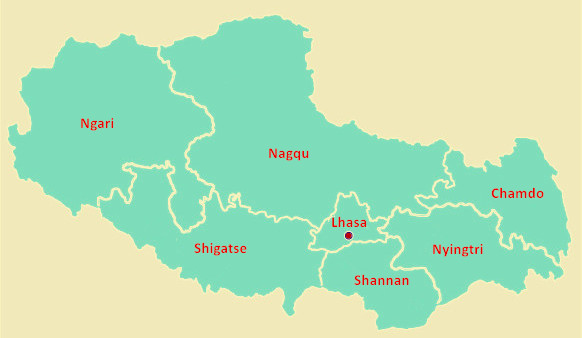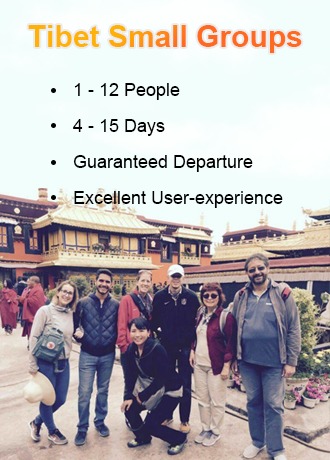Tibet Altitude - Elevation List of Different Places in Tibet
- by Apple
- Last Updated: 2023-02-05
 Tibetan Plateau is the world's highest plateau, with an average altitude of 4,500 meters/ 14,750 ft. It's known as the "roof of the world" and "Third Pole" due to its high elevation. It is highly suggested to spend about 3 nights in Lhasa or Tsetang, the relatively lower altitude places of Tibet first before moving further to other higher altitude places.
Tibetan Plateau is the world's highest plateau, with an average altitude of 4,500 meters/ 14,750 ft. It's known as the "roof of the world" and "Third Pole" due to its high elevation. It is highly suggested to spend about 3 nights in Lhasa or Tsetang, the relatively lower altitude places of Tibet first before moving further to other higher altitude places.
Actually the lowest place in Tibet is Nyingchi with an elevation of 3,000 meters/ 9,843 ft, and the highest place in Tibet is Ngari, with an elevation of 4,500 meters/ 14,764 ft.
Here Great Tibet Tour provides you with the altitude of Tibet's towns & attractions, both in meter and feet, in order to give you a rough idea of what you will be dealing with, also to help you select sights suits you best.
Altitudes of Major Places
The Altitude of Prefectures/Cities/Towns
| Prefecture | Elevation by Meter | Elevation by Feet | City/Town | Elevation by Meter | Elevation by Feet |
| Lhasa | 3,650 m | 12,100 ft | Lhasa | 3,650 m | 12,000 ft |
| Shigatse | 3,800 m | 12,500 ft | Gyantse | 4,000 m | 13,123 ft |
| Shigatse | 3,800 m | 12,467 ft | |||
| Tingri | 4,300 m | 14,108 ft | |||
| Zhangmu | 2,800 m | 9,186 ft | |||
| Ngari | 4,500 m | 14,800 ft | Shiquanhe (Ali/Ngari) | 4,280 m | 13,960 ft |
| Nagqu | 4,500 m | 14,800 ft | Nagqu | 4,500 m | 14,764 ft |
| Damxung | 4,200 m | 13,780 ft | |||
| Amdo | 4,800 m | 15,748 ft | |||
| Shannan | 3,700 m | 12,100 ft | Tsetang | 3,580 m | 11,745 ft |
| Nyingchi | 3,100 m | 10,200 ft | Nyingchi | 3,100 m | 10,171 ft |
| Pomi | 2,750 m | 9,022 ft | |||
| Chamdo | 3,200 m | 10,500 ft | Chamdo | 3,200 m | 10,499 ft |
Altitude of Attractions
| Attraction | Elevation by Meter | Elevation by Feet |
| Lake Namtso | 4,700 m | 15,420 ft |
| Yamdroktso Lake | 4,500 m | 14,764 ft |
| Tashilunpo Monastery | 4,800 m | 15,748 ft |
| Sakya Monastery | 4,300 m | 14,108 ft |
| Rongbuk Monastery | 5,100 m | 16,732 ft |
| Mt. Everest Base Camp | 5,200 m | 17,060 ft |
| Samye Monastery | 3,556 m | 11,667 ft |
| Yumbulagang Palace | 3,700 m | 12,139 ft |
| Lake Manasarovar | 4,588 m | 15,052 ft |
| Mount Kailash | 6,638 m | 21,778 ft |
| Draksumtso Lake | 3,700 m | 12,139 ft |
The Altitude of Lhasa
Lhasa, the capital of Tibet, is located in the middle of the Tibetan Plateau with an elevation of 3,650 meters/12,000 ft. It is one of the highest cities in the world and also a world-famous tourist attraction. The altitude of Lhasa can already cause altitude sickness, but with a little attention, most people can adapt to the plateau environment of Lhasa. >>See more elevation of Lhasa
The Altitude of Mount Kailash
Mount Kailash is located in Burang County, Ngari Prefecture, Tibet with an elevation of 6638 meters/21,778 ft. It's the main peak of the Gangdise Range. Mt. Kailash is a world-recognized sacred mountain. For tourists who are sensitive to altitude sickness, it is recommended to adapt to the plateau climate in Lhasa well before going to Mt.Kailash.
The Altitude of Everest Base Camp
Mount Everest is located in the middle section of the Himalayas, at the border of China's Tibet Autonomous Region and Nepal. The base camp on the southern slope of Mount Everest is located under the Khumbu Glacier in Nepal at an altitude of 5,364 meters. The northern slope of Mount Everest is located in Tingri County, Tibet at an altitude of 5,200 meters.
The Altitude of Namtso Lake
Namtso Lake is located 200 kilometers north of Lhasa. Namtso Lake is more than 4,700 meters above sea level, making it the highest saltwater lake in the world. Namtso, known as the Heavenly Lake, is a famous sacred place of Tibetan Buddhism and one of the most popular tourist destinations in Tibet.
Tips about Altitude Sickness
Altitude Sickness is a natural physiological discomfort due to changes in air pressure caused by high altitude, low oxygen content, and dry air when someone gets to a place with a high elevation, usually 3,000 meters (9,843 feet) and up. The symptoms are Headaches, fast heart beating, loss of appetite, difficult breathing, etc. Most people will experience one or more symptoms but the symptoms will disappear within one or two days. The following tips can help you get adapted to the altitude soon:
Before Your Trip to Tibet
1. Keep your body healthy and avoid cold. If you catch a cold before departure, it is best to postpone your trip or change your itinerary.
2. Prepare drugs for Altitude Sickness. Enough drugs can ensure a safe and smooth journey. The recommended drugs are Diamox(for insufficient oxygen supply), Dexamethasone(for brain swelling), and Ibuprofen(for mild headaches and physical discomfort).
3. Taking a train to Tibet, the body has a relatively slow process of adapting to the altitude. When altitude sickness occurs, it should happen in steps. In this way, you can avoid sudden entry from a low altitude place to Tibet, which will greatly reduce the probability of altitude sickness.
4. Avoid drinks containing alcohol and caffeine 48 hours before entering Tibet.
During Your Tibet Trip
1. After reaching an altitude of 3,000 meters or above, please stay at this altitude for 1-3 days to adapt to the environment
2. On the first day in Tibet, do not rush to take a shower and wash your hair. The plateau is dry, and when the body temperature is too high, it will increase the body's oxygen consumption. If you do not keep warm, it will also cause high altitude colds and pulmonary edema, which is life-threatening.
3. Reasonably arrange the itinerary to ensure adequate rest and sleep
4. Maintain a good attitude. Too much worry will lead to anxiety and poor sleep. On the contrary, it will increase the oxygen consumption of brain tissues and cause altitude sickness, or aggravate altitude sickness.
5. A reasonable diet, eat more fruits and vegetables, mainly light, avoid alcohol.
6. Keep warm and avoid colds. The weather changes in plateau areas and the temperature difference between day and night is large, and colds can easily aggravate altitude sickness.
7. Avoid strenuous exercise during travel and take proper rest.
8. Don't rely too much on oxygen tanks.
9. If you feel any altitude discomfort, do not continue to ascend the altitude and rest on the spot. If altitude sickness intensifies or no improvement after resting, you should go to a low altitude and immediately lower the altitude.
Related Articles
- Lhasa to Everest Base Camp
- Nomad Tents at Everest Base Camp
- Weather and Climate of Everest Base Camp
- Best Time To Visit Everest Base Camp
- Tibet Landscape
- Tibet Attractions
- Tibet Spiritual Vacations
- Tibetan Buddhism Facts
- Tibetan Plateau - The World's Highest Plateau
- Lhasa Altitude: Main Attractions with Various Elevations
Email response within 0.5~24 hours.



